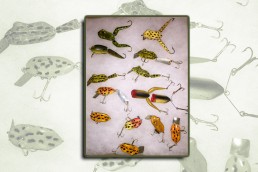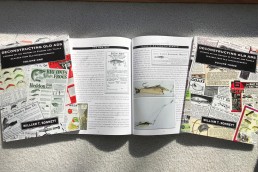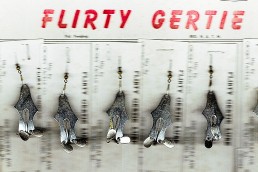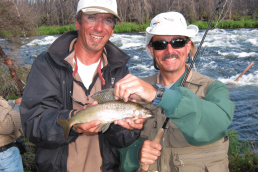Finding Old Tackle is just a Start
SHARE THIS POST
One day last summer as my granddaughters were fishing at my place, the cellphone rang.
“How does this work?” asked the caller. “I got your card at the Chicago Sports Show even though I didn’t have any old tackle. My neighbor is moving and gave me an old tackle box that someone had given him. Should I email the pictures or bring them over for you to see?”
“It’s always best to see them in person, if possible,” I replied to the caller.
Since it was just a 45-minute drive, he soon arrived with his grandson who then started to learn fishing from the girls.
The tackle box held some neat lures. Some were modified baits whose origins were known while others were unfamiliar to me even though I’ve been studying, researching and collecting baits for 60 years. I classified them as “great modified” and “homemade lures” and then traded several Benjamin Franklins for them.
The next day I sent pictures of my find to top researchers, identification guide authors and collectors.
They replied, echoing my thoughts: “Neat but homemade,” they said.
One avid collector as far as New Mexico responded.
“Since many are frog and pollywog imitations,” she said, “I’ll email these to a collector in Canada who specializes in frog lures.”
Rolly Brunet, someone up in Winnipeg, Manitoba who I knew, replied immediately.
“Wow! That is the largest selection of Holmgren frogs and lures I’ve ever seen. These are something special.”
I had met Rolly a few years earlier. He’s an avid angler who became quadriplegic as a result of an automobile accident. He retains interest and enthusiasm by collecting and diligently researching patents, sales, eBay and other sources for information on old lures. He was the only one who could or would share the identity of this find.
With the patent copy Rolly shared, we learned that Fred P. Holmgren of Chicago had filed for a patent on his fishing lures on June 2, 1949. It wasn’t until August 5, 1952 that one was issued to him.
Now, I really wanted to meet this maker.
An online search revealed that Fred was married to a Betty and that there was a listing for Betty on Chicago’s North Side. I wrote to her and enclosed several of my articles, brochures and a business card. I asked for a meeting, but got no reply.
Are you enjoying this post?
You can be among the first to get the latest info on where to go, what to use and how to use it!
After a couple of weeks, I drove to her address to continue the quest. The location turned out to be a nice, secure, senior living building with a friendly and cooperative receptionist who buzzed me in. She disclosed that it was lunchtime and that I should return in an hour to see Betty.
I was excited to be close to meeting the wife of the maker of Holmgren lures. I happily walked the many blocks where a parking spot had been found and took off for lunch. Later, when I finally returned from the long walk, the receptionist was most helpful saying she had talked with Betty and Fred Holmgren and that they looked forward to seeing me in five minutes. “Wow, did you say Fred is still alive?” I asked the receptionist.
“Oh yes. He’s eager to see you.”
I entered their room to find both Betty and Fred sitting in wheelchairs.
“Oh, Hi. I remember you!” Fred said, greeting me.
I assumed he’d seen my Historical Fishing Display at the local outdoors and sports shows.
“Sorry we haven’t replied to your letter. We found it fascinating. We both grew up on prime fishing lakes in Minnesota and Wisconsin.”
Then, the excitement reversed as Fred continued.
“We find it fascinating that there was another Fred and Betty Holmgren near us that we’d never heard of. Neither of us liked fishing and I was a theology professor. You look like one of my former students.”
Further research found that after waiting three years, two months for his patent, the real Fred had tried to get Bill Cullerton’s rep group to market his lures.
But Bill then asked the killer question to all such lure makers: “What kind of demand is out there for your lures?”
Tackle companies then, as now, spend lots of money with ads, catalogs, articles, show exhibits, TV and radio programs, outdoors shows and more. This is not what distributors and retailers do. Since he’d spent so much money on attorneys, draftsmen and time perfecting and making his lures, Fred closed the tackle box and his dream of making it big selling lures ended.
More searches revealed that Fred Phillip Holmgren was born April 24, 1899, and had died November 29, 1957. He was buried December 2, 1957, with a last known address on N. Cicero Avenue in Chicago.
Hopefully, we’ll find out more about him and his rare lure.
MWO
SHARE THIS POST
Did you enjoy this post?
You can be among the first to get the latest info on where to go, what to use and how to use it!
Dan Basore
Dan Basore is a fishing historian and steward of the history of the sport. In his efforts to preserve fishing history, he is always on the lookout for information about early lure makers, old lures, pre-level wind reels, manufacturer catalogs, tournament casting items and the like. If you possess information or materials of this kind, please contact him at 630-393-3474 or by email at ollures@aol.com.



